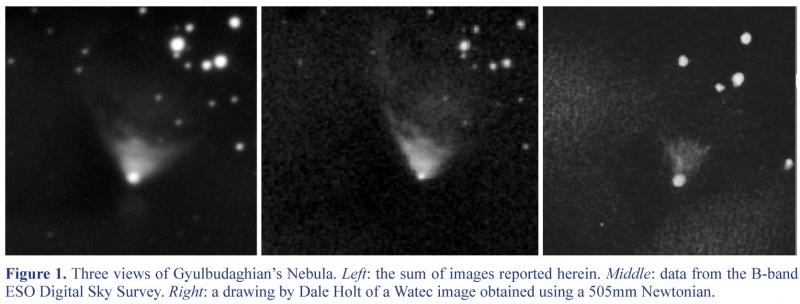The many faces of Gyulbudaghian’s Nebula
2019 October 2
Introduction
Variable nebulae are a small class of nebulae whose appearance changes significantly over astronomically short timescales of years, months or days. They have been known since the 1800s, with the most familiar being Hubble’s Variable Nebula (NGC 2261) in Monoceros, Hind’s Nebula (NGC 1555) in Taurus and NGC 6729 in Corona Australis. In recent years the list has been added to, with McNeil’s Nebula found in 2004, and the reporting of the V900 Mon Thomme’s Nebula in 2011.
First recorded in 1977 by Armen Gyulbudaghian and Tigran Magkyan, Gyulbudaghian’s Nebula is a bipolar nebula located in the northern hemisphere constellation of Cepheus. It is associated with the Herbig Ae/Be-type, pre-main sequence star PV Cephei, which is estimated to be of three solar masses (depending upon the distance assumed). Gyulbudaghian’s Nebula consists of a relatively dim emission nebula that is sporadically outshone by a reflection nebula component, spanning approximately 1.5×1.0arcmin, which is illuminated by PV Cephei. The nebula forms a minor part of a much larger complex of dark nebulosity, LBN 468, which is run through with thick regions of obscuring dust spanning several degrees, and which extends nearly as far as NGC 7023. If the distance to PV Cephei is assumed to be around 343pc, lower than that quoted in some older Gyulbudaghian-associated publications, the visible part of the nebula extends to less than one light-year north of PV Cephei.
PV Cephei possesses an unevenly populated active accretion disk which gives rise to a substantial polar outflow of high-velocity gas and dust. This is aligned north and south of the star, with the axis tilted slightly towards us out of the plane of the sky: we are therefore looking into a cone, partially cleared by the north polar flow. The apparent tilt of the northern fan to the west probably results from local gas cloud conditions; the dimmer opposite cone projects south into the dust cloud where it suffers considerable extinction – beyond the 5–7 magnitudes already experienced by PV Cephei itself… (continued)
(Login or click above to view the full illustrated article in PDF format)
| The British Astronomical Association supports amateur astronomers around the UK and the rest of the world. Find out more about the BAA or join us. |
